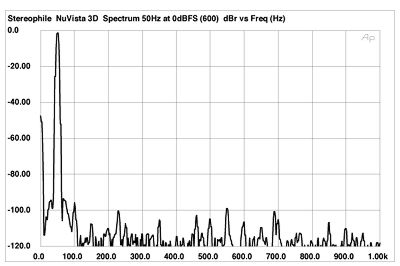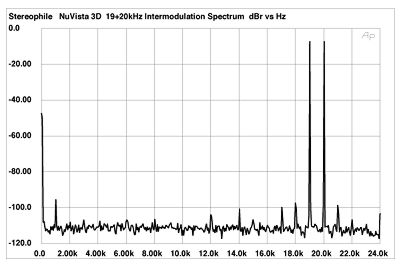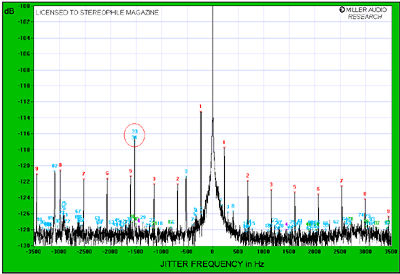| Columns Retired Columns & Blogs |
Musical Fidelity Nu-Vista 3D CD player Measurements part 2
The player's analog stage appears to consist of a single nuvistor tube per channel, each driving a complementary pair of TO220-packaged output transistors. It's effectively bombproof; the only significant harmonic present in the 3D's output with the player driving a 0dBFS, 50Hz tone into a punishing 600 ohm load was the second (fig.6), at a negligible -97dB (0.003%). It was a similar story with the high-frequency intermodulation test, where the only spurious product to poke its head above the -100dBFS line in the Musical Fidelity's output was the difference tone at 1kHz, even into 600 ohms (fig.7).

Fig.6 Musical Fidelity Nu-Vista 3D, spectrum of 50Hz sinewave, DC-1kHz, at 0dBFS into 600 ohms (linear frequency scale).

Fig.7 Musical Fidelity Nu-Vista 3D, HF intermodulation spectrum, DC-24kHz, 19+20kHz at 0dBFS into 600 ohms (linear frequency scale).
Finally, I assessed the Nu-Vista 3D's rejection of word-clock jitter with the Miller Audio Research analyzer. This drives the device under test with a test signal consisting of a high-level 11.025kHz (Fs/4) tone, over which is overlaid a 229Hz squarewave at the LSB level. With the 2s-complement encoding used by the CD's LPCM system, this results in all bits simultaneously changing state—very much the worst case when it comes to generating jitter. The analyzer software then averages sixty-four 32,536-point FFTs to derive a high-resolution spectrum of the player's analog output signal, and identifies symmetrical pairs of sidebands around the 11.025kHz tone that will be due almost entirely to jitter.
The result for the 3D is shown in fig.8. The weighted jitter level is a very low 156.3 picoseconds peak-peak, almost all of this due to a pair of sidebands at the data frequency of ±229Hz (red "1" numeric markers), with the odd harmonics also visible at a much lower level. The noise floor lies at around -129dBFS, which is excellent, if a couple of dB higher than the lowest I have measured with this test. However, a closely spaced pair of spurious tones can be seen at 9.5kHz (blue "33" and "34" markers, ringed in red). Note also how the central peak is spread out in frequency for about 500Hz to either side of the actual frequency. This is due, I imagine, to low-frequency jitter with a random-noise characteristic, which tends to enlarge the player's soundstage at the expense of a slight amount of perceived pace.

Fig.8 Musical Fidelity Nu-Vista 3D, high-resolution jitter spectrum of analog output signal (11.025kHz at -6dBFS with LSB toggled at 229Hz). Center frequency of trace, 11.025kHz; frequency range, ±3.5kHz.
All things considered, this is excellent measured performance that gives no clue of the presence of tubes in the analog circuitry; only the jitter spectrum suggests that the Nu-Vista's sound has any "character" at all.—John Atkinson
- Log in or register to post comments



































